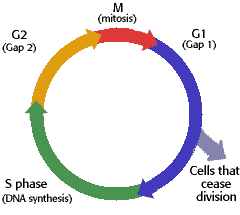 Interphsae Mitosis
Interphsae Mitosis -----
-synthesize RNA -centromeres separate
-produce proteins -microtubule stretche
-Checkpoint: Everything ready for
-----
-If cell too small -Nuclear membrane broken
-unfavorable environment
-then delay cell duplication ----Metaphase
-chromatids align on plate
-----Apoptosis
-p53 recognize damaged cell ----Anaphase
-if unable to repair damage -chromatids separate
- macrophage recognize and disassemble cell -separate to ends
- building blocks reused
----Telophase
-----S Phase -nuclear membrane reformed
-
-All
-cell pinches in two
-----Gap 2
-grow and produce proteins
-Checkpoint: Can proceed to mitosis to divide?






